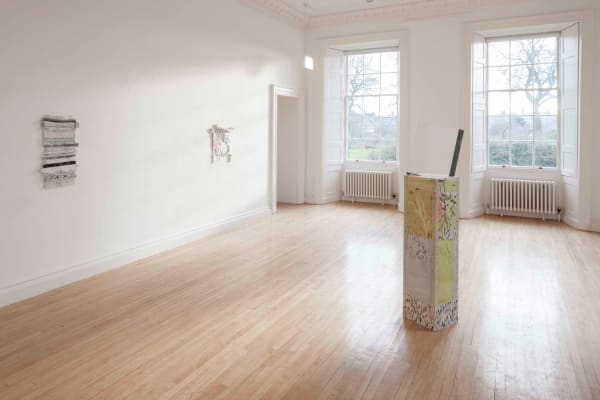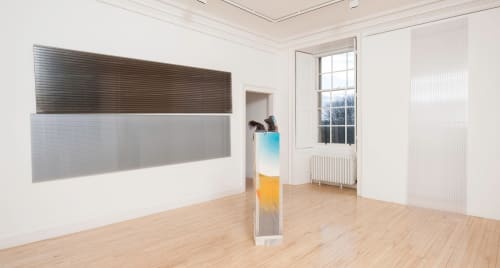persitencebeatsresistance
Inverleith House is delighted to launch its 2014 exhibitions programme witha major solo exhibition by Alex Dordoy (b.1985, Newcastle-upon-Tyne), hisfirst in a UK public gallery. Made for Inverleith House, all of the works inpersistencebeatsresistance are being exhibited for the first time: paintings,sculptural plinths, cast objects and large wall drawings have been installedby the artist throughout the gallery in its seven ground and first–floor rooms.Dordoy’s working methods embrace both skilled craft and high technology,use existing objects, photographs, images and patterns and co-optprocesses which reference reproduction and duplication. Dordoy casts andmoulds using materials such as plaster, glass and silicone; he reproducesimagery by scanning, printing, photocopying and by direct transfer; and hemanipulates images digitally using computer software or the application ofpaint. In this way Dordoy builds up layers of reference and association untilthe original sources become remnants.
persistencebeatsresistance pivots around two sculptural objects: a smalltotem pole made from a bust of the revolutionary socialist Karl Marx; and agutted, disassembled photocopier.
The totem is a vertical assemblage of plaster casts taken from a woodenbust of Karl Marx (1818–1883) hand-carved by Dordoy’s father. Marx’shead and shoulders are stacked in vertical formation in a playful homage toboth Marx and the artist’s father. This stern, yet absurd portrayal of Marxevokes the politics of reproduction and places the exhibition within acritique of capitalist systems and labour economies. Depicted as a totem,Marx is put forward as a talismanic figure of worship, whilst the ironicrepetition of his form draws attention to the material qualities of the objectitself, subtly undermining the great philosopher and economist’s principals. Meaning, for Dordoy evolves elliptically and is fundamentally transient. The photocopier, which itself is a totem of modern office culture ispresented in the exhibition as a sculptural object. Redolent of the workplaceand a ubiquitous tool of cheap and ready reproduction, the photocopier hasoften been used as a motif by Dordoy. Here, the machine has been dissected and its internal components have themselves been copied in ways (and for purposes) never originally intended. A number of ‘skins’ have beenproduced from these elements – created by pouring lightly pigmentedsilicone over the copier’s deconstructed parts, which have then been peeledoff and now occupy the gallery walls. These odd, translucent skins seem tosuggest something raw and organic, like a carapace drawn out from withinthe machine. The brutalised photocopier is seen as a metaphor for the cultof reproduction in contemporary society and its instrumental role in theworkplace again references Marx.
The exhibition is elsewhere populated by a number of decorative plinths:cast in Jesmonite and embellished with transfers, they do not supportobjects, but rather appear to have absorbed them into the display unit itself. The ornamentation applied to these plinths using laser-printed transfersderives from the markings on ancient Chinese burial objects called ‘congs’, whose original purpose was to carry the souls of the dead to the next world.Here, the borrowed patterns still evoke the object’s transcendent powerand original use, yet this small shift from the spiritual to the commonplaceprovides an unexpected bathos.
Dordoy’s innovative and investigative use of such hand-made andmechanical processes invites imperfections and proposes different readingsand meanings. He deliberately employs skill and technique to gather ‘flawed’results. The digital software programme Photoshop, for example, is commonly used to manipulate or prepare photographic images for professional reproduction but Dordoy uses it to skew, warp and distortimages which are in turn used as the basis for paintings, whilst cast sculptural objects are then used as the basis for the application of painted, borrowed designs.
By appropriating and distorting the techniques and methods ofreproduction, Dordoy apprehends the sleek continuity of the work of art inour digital age and turns it inside out. For him, imitation is not seen as an endpoint but rather as part of something more akin to anthropological enquiry.One of Dordoy’s primary concerns is to deal with ‘the afterlife of objects’; their ability to evolve and project transformations of information andmeaning through time. In so doing, he proposes an open-endedrenegotiation of ideas, forming obscure connections, evoking personal and sentimental allusions and playful associations selected from cultures pastand present, distant and immediate.




